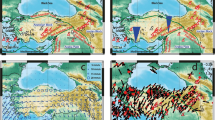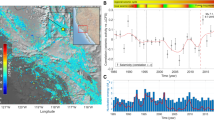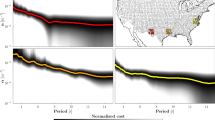Abstract
The existence of anistropy in the propagation speed of seismic waves through the Earth's crust has been attributed to the non-random alignment of microcracks in the crust1. For sparsely distributed, parallel vertical cracks, perturbation theory predicts the splitting of a shear wave into two orthogonally polarized waves2–4. Here we present extremely clear evidence for shear-wave splitting in three-component seismograms from crustal and sub-crustal microearthquakes recorded in the Shikoku district of Japan. Quantitative analysis of travel-time differences between split shear waves leads to the conclusion that the observed anisotropy is limited to the upper crust, shallower than 10–15 km. This model is consistent with recent results from reflection seismology5, and implies that microcrack density or orientation changes from the upper to the lower crust.
This is a preview of subscription content, access via your institution
Access options
Subscribe to this journal
Receive 51 print issues and online access
$199.00 per year
only $3.90 per issue
Buy this article
- Purchase on Springer Link
- Instant access to full article PDF
Prices may be subject to local taxes which are calculated during checkout
Similar content being viewed by others
References
Crampin, S. Nature 328, 491–496 (1987).
Crampin, S. Geophys. J. R. astr. Soc. 53, 467–496 (1978).
Crampin, S. Geophys. J. R. astr. Soc. 76, 135–145 (1984).
Hudson, J. A. Geophys. J. R. astr. Soc. 64, 133–150 (1981).
Mooney, W. D. & Brocher, T. M. Geophys. J. R. astr. Soc. 89, 1–6 (1987).
Crampin, S. & McGonigle, R. Geophys J. R. astr. Soc. 64, 1115–1131 (1981).
Booth, D. C., Crampin, S., Evans, R. & Roberts, G. Geophys. J. R. astr. Soc. 83, 61–73 (1985).
Kaneshima, S., Ando, M. & Crampin, S. Phys. Earth planet. Inter. 45, 45–58 (1987).
Kaneshima, S., Ito, H. & Sugihara, M. Tectonophysics (in the press).
Hudson, J. A. Math. Proc. Camb. phil. Soc. 88, 371–384 (1980).
Ando, M. J. Phys. Earth 32, 179–195 (1984).
Ando, M., Ishikawa, Y. & Wada, H. Nature 286, 43–46 (1980).
Hashimoto, M. Tectonophysics 84, 247–266 (1982).
Okano, K., Kimura, S., Konomi, T. & Nakamura, M. Mem. Fac. Sci. Kochi Univ. 1B, 1–13 (1980).
Kehle, R. O. J. geophys. Res. 69, 259–273 (1964).
Christensen, N. I. J. geophys. Res. 11, 3549–3556 (1966).
Kaneshima, S. & Ando, M. Abstr. seismol. Soc. Japan 2, 215 (1986).
Author information
Authors and Affiliations
Rights and permissions
About this article
Cite this article
Kaneshima, S., Ando, M. & Kimura, S. Evidence from shear-wave splitting for the restriction of seismic anisotropy to the upper crust. Nature 335, 627–629 (1988). https://doi.org/10.1038/335627a0
Received:
Accepted:
Issue Date:
DOI: https://doi.org/10.1038/335627a0
Comments
By submitting a comment you agree to abide by our Terms and Community Guidelines. If you find something abusive or that does not comply with our terms or guidelines please flag it as inappropriate.



